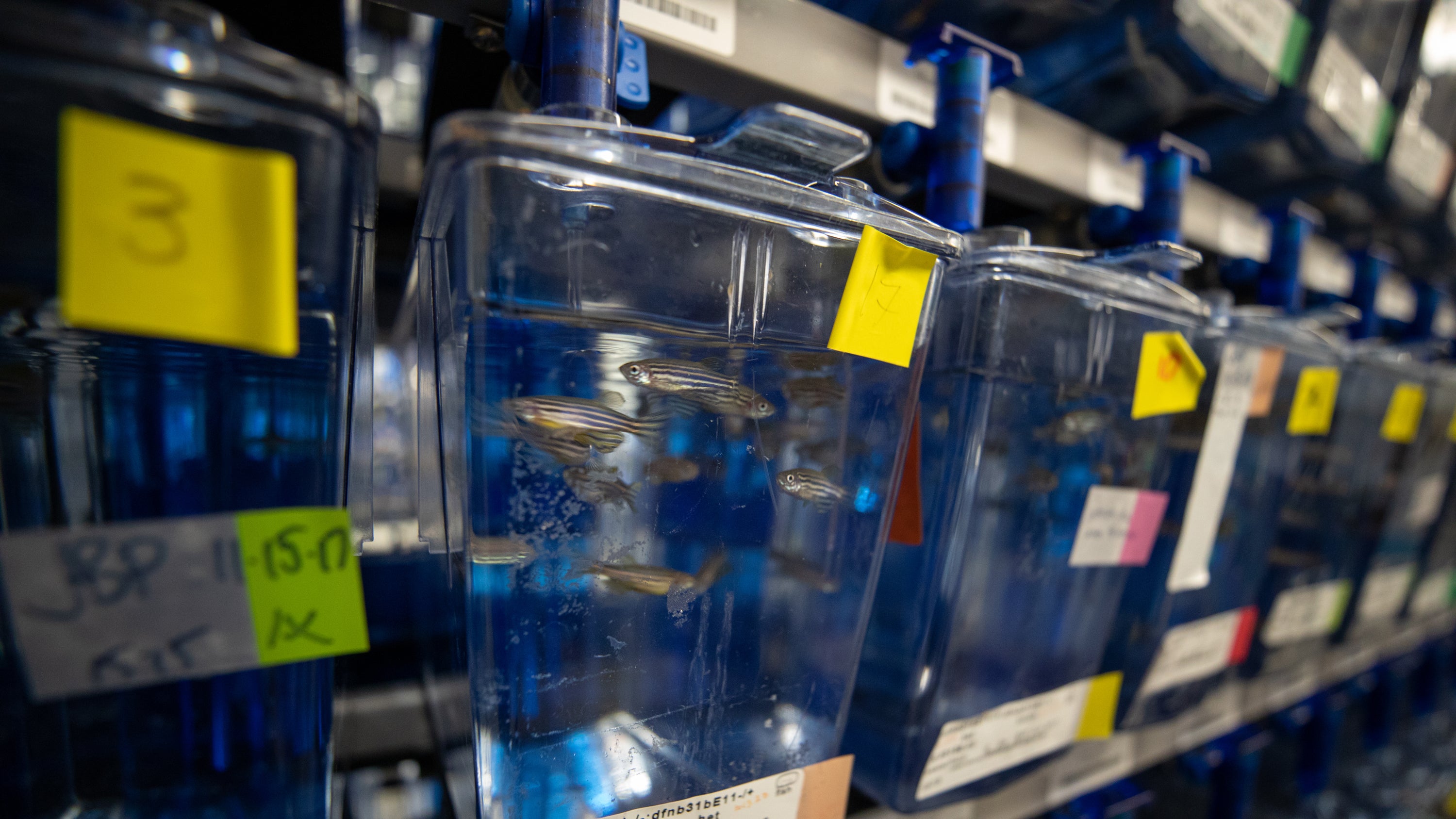Zebrafish
The transparent fish that transformed fundamental life science research
It all started in 1981, when geneticist and UO professor George Streisinger published a paper showing a new method to clone a vertebrate (15 years before Dolly the sheep). Of course, the work started earlier than this in the late 1960s, when Charline Walker and George brought the first zebrafish into the lab from a local pet store. By cloning zebrafish, Streisinger established the animal as an outstanding choice for genetic research on vertebrates and established the University of Oregon as one of the nation’s prime sites for molecular genetics research.
A key to the power of zebrafish is that their genetic makeup is similar to humans—approximately 85% of human disease-associated genes are present and function similarly in zebrafish and humans. The ease of studying zebrafish, and their perhaps surprising similarities to us, allow researchers to readily translate their findings to humans.
Four decades after Streisinger’s scientific achievement, scientists at the UO continue to conduct groundbreaking research in neuroscience, genetics, developmental biology, and animal interactions with their microbiota—all using the tiny striped fish. The UO is also home to the Zebrafish Information Network (ZFIN) and the Zebrafish International Resource Center (ZIRC), which maintain infrastructure for zebrafish information sharing and collaboration and provide genetic strains to other labs around the world.

Research Facilities, Centers, and Institutes

The Institute of Molecular Biology is a group of biologists, chemists, and physicists at the University of Oregon who have pooled their expertise to tackle fundamental questions in molecular biology. Researchers use a wide variety of biological systems, from germ-free zebrafish to in vitro-reconstituted molecular machines to computational models.
Institute of Neuroscience (ION) scientists research questions of developmental biology and computational systems, and motor and cognitive neuroscience. ION is also affiliated with the UO’s undergraduate major in neuroscience. The institute features a “Zebrafish groupies” weekly meeting of labs that use the fish as a model system in their research.
The Institute of Ecology and Evolution facilitates research and graduate education in ecology and evolutionary biology. Faculty from biology, chemistry, computer science, geography, geology, and landscape architecture study molecular evolution, evolutionary genetics, evolution of development, and microbial, population, community, and ecosystems ecology.
The Zebrafish International Research Center provides a central repository for wild-type and mutant strains of zebrafish (Danio rerio) and for materials and information about zebrafish research to labs worldwide.
A sister resource to ZIRC, the Zebrafish Information Network (ZFIN) is an on-line database of information about zebrafish genetics, genomics, and development. ZFIN integrates information about the genetic map being generated by the zebrafish genome initiative and provides links to related information about genes in other species-specific databases. Researchers can use ZFIN to register and submit to the nomenclature committee new names for mutant alleles and for genes identified by molecular cloning.
GC3F supports life science research with advanced instrumentation, including DNA sequencing, advanced light microscopy, flow cytometry, sample prep, microscopy, and fragment analysis.
Training the Next Generation
Funded by a T32 grant from the National Institute of General Medical Science, the Genetics Training Grant recruits and trains diverse students, including students with disabilities and underrepresented minorities, in the subdisciplines of developmental genetics, molecular genetics, and evolutionary genetics.
Funded by a T32 grant from the National Institute of Child Health and Human Development, the Developmental Biology Training Grant prepares leaders of the next generation of rigorous, creative, and experimentally talented developmental biologists. Trainees develop the skills to lead research programs of their own, communicate discoveries to other scientists and the public, and teach future scientists.
The Molecular Biology and Biophysics Training Program brings together scientists from biology, chemistry and biochemistry, and physics, as well as from the Knight Campus for Accelerating Scientific Impact. The program provides excellent training in technical, operational and professional skills needed in molecular biology and biophysics through interdisciplinary training that combines quantitative and modern coursework together with individual mentored research experiences.
UO PREP Bio is a National Institutes of Health-funded, one-year post-baccalaureate program serving scholars from groups that are underrepresented in health-related sciences—including individuals from historically excluded groups, individuals with disabilities, and individuals from disadvantaged backgrounds—on their journey to advanced biomedical degree programs. UO PREP Bio emphasizes community building and use of evidence-based methods to support diverse scholars’ further development of technical skills, professional savvy, and persistence.
In 2023, neuroscience senior Nayantara Arora was awarded a Rhodes Scholarship for graduate study at the University of Oxford.

Collaborations

The Microbial Ecology and Theory of Animals (META) Center for Systems Biology studies how host-microbe systems work and uses this knowledge to advance human health. The center is funded under National Institutes of Health (NIH) award “Engineering Transmissible Health” and an NIH R24 to fund zebrafish research, “A Single-Cell Transcriptome Atlas for Zebrafish Development.”

